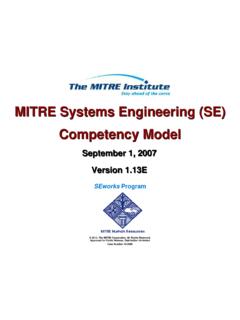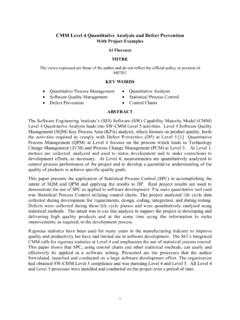Transcription of Overview of the GPS M Code Signal - Mitre Corporation
1 Overview of the GPS M code SignalCapt. Brian C. Barker, US Air Force, GPS Joint Program OfficeJohn W. Betz, The Mitre CorporationJohn E. Clark, The Aerospace CorporationJeffrey T. Correia, The Mitre CorporationJames T. Gillis, The Aerospace CorporationSteven Lazar, The Aerospace CorporationLt. Kaysi A. Rehborn, US Air Force, GPS Joint Program OfficeJohn R. Straton, III, ARINCBIOGRAPHIESCapt. Brian C. Barker received a in ElectricalEngineering from the Georgia Institute of Technology. Inhis initial assignment to the 2d Space Operations Squadronat Schriever Air Force Base, Colorado, he was a NavigationPayload operator and the GPS Tactics and NavigationPayload Analyst, where he was responsible for monitoringsignals in space, resolving satellite and ground systemanomalies, designing concepts and operational proceduresfor GPS warfighting tactics and the GPS User SupportSystem, and directing satellite maintenance actions.
2 InMarch 1999, Capt. Barker transferred to the GPS JointProgram Office (JPO) in the Space and Missile SystemsCenter at Los Angeles Air Force Base, where he leads theGPS Modernization Signal Design Team (GMSDT)designing the new military Signal , and directs developmentof a new security architecture for military W. Betz is a Consulting Engineer at The MITREC orporation. He received a in Electrical andComputer Engineering from Northeastern University. Hiswork involves development and analysis of signalprocessing for communications, navigation, radar, and otherapplications. During 1998 and 1999, Dr. Betz ledGMSDT s Modulation and Acquisition Design Clark received a in Physics and a inEngineering from the University of California at LosAngeles.
3 He has over 20 years of experience at TheAerospace Corporation . Since 1985, he has advised theGPS Joint Program Office and US government on theengineering, management, and use of T. Correia received the BSEE and MSEE degreesfrom Northeastern University in 1988 and 1990respectively. He has been with The Mitre Corporation inBedford MA since 1990 where he has worked on waveformdevelopment and antijam Signal processing for spreadspectrum based communications systems. Most recently hehas been working on the modernization of the GPS signalfor the military. Mr. Correia was appointed by the GPSJPO to lead the GMSDT s subteam responsible forpreliminary verification of the M code Signal T.
4 Gillis is a Senior Project Engineer in the GlobalPosition System Division, Military Utilization Directorate,of the Aerospace Corporation . He received a BS in SystemScience and Applied Mathematics from WashingtonUniversity in 1979, and a in Electrical Engineeringfrom the University of California at Los Angeles in has been a member of the GPS Selective Availabilityand Anti Spoofing Module team, and was co-chair of theGMSDT s Security Design Steve Lazar received his and from theUniversity of California at Los Angeles. Currently, he is asenior project leader with over 20 years of experience at TheAerospace Corporation . He has spent the last 9 yearssupporting the GPS JPO and the Federal AviationAdministration, with responsibilities that include signaldesign and spectrum Kaysi A.
5 Rehborn graduated from the University ofColorado with a Bachelor of Science degree in AerospaceEngineering. Her systems engineering work at the GPSJPO has ranged from spectrum allocation to developingnavigation warfare strategies and technologies. FromOctober 1998 to June 1999, Lt. Rehborn was lead engineerresponsible for M code Signal development; she now leadsthe acquisition and engineering efforts implementingModernization on the Block IIF satellites. She is a Mastersof Business Administration student at Webster R. Straton, III is a Principal Engineer with ARINCI ncorporated in El Segundo, California. He received his BSin Astronautical Engineering from the United States AirForce Academy.
6 He has over 15 years of experience in GPS,including five years assignment to the GPS OperationalControl System as Instructor for Navigation PayloadOperations. Since 1989, Mr. Straton has supported theSystems Engineering Directorate of the GPS JPO. During1998 and 1999, he led the GMSDT s subteam for thedevelopment and design of the navigation data the past year, the GPS Military Signal Design Team(GMSDT), led by the GPS Joint Program Office (JPO), hasproduced a recommended design of the new military signalfor the L1 and L2 bands. This paper synopsizes theresulting M code Signal design, which is to be implementedin modernized satellites and in a new generation of paper summarizes the history that led to GPSM odernization with a new military Signal on L1 and an Overview of the M code Signal design, the paperdescribes the modulation design, along with aspects of thedesign for Signal acquisition and the data message.
7 It alsooutlines some of the aspects of implementing M codesignal transmission on modernized satellites, and M codesignal reception in a new generation of User for refinement and further verification of the designare motivations for GPS Modernization, as an essentialpart of GPS navigation warfare (NAVWAR), have beenaptly described summarized in [1] and its references. Theobjectives of the modernized military Signal in the contextof NAVWAR are protecting military use of GPS by the USand its allies, preventing hostile use of GPS, whilepreserving the peaceful use of the civil radionavigationservice. Furthermore, Modernization entails improvingperformance of GPS service for both civilian and militaryusers, while recognizing that the threat against the militaryuser may continue to increase.
8 Thus, the job of the GPSM odernization Signal Design Team (GMSDT) was todesign a Signal that provides functions, performance, andflexibility for an enhanced military radionavigation service,while ensuring that current military and civilian receiverscontinue to operate with the same or better performance asthey do some of the proposed approaches during earlyconsideration of GPS Modernization involved newfrequencies other than the existing carriers at L1 ( ) and L2 ( MHz), the technical and regulatorybenefits of operating within the existing radionavigationsatellite service (RNSS) bands, coupled with the scarcity ofL-band or other spectrum, constrained any new militarysignal to the currently registered GPS bands.
9 The challengewas to identify designs for the combined architecture of civiland military signals that would fit within the bands buthave sufficient isolation to prevent mutual the is intending to discontinue the use ofSelective Availability, C/A on L1 will be even moreimportant for civilian and aviation use. With the VicePresidential announcement in March 1998, the C/A codesignal will be transmitted on L2 as well. In addition, a newcivil Signal is planned at MHz [2].During 1997 and 1998, the JPO led an initial investigationinto the design of a new military Signal for use on L1 andL2. Several fundamentally different Signal architectures wereconsidered, along with various modulation designs andalternatives for transmitting the new Signal from spacevehicles.
10 As described in [1] and its references, this workculminated in the conclusion that frequency reuse wasfeasible, that the Signal architecture on both L1 and L2should include C/A code signals in the center of each bandfor civil use while retaining the Y code Signal , and that thenew military Signal should use a split spectrum modulation that placed most of its power near the edges ofthe allocated bands. Further, the results showed that anoffset carrier modulation [3] was the best option, and thatthere were distinct advantages for transmitting the new Mcode Signal through a separate RF chain and antennaaperture on the in 1998, the JPO formed the GMSDT to examinefurther the modulation design, while designing othercomponents of the M code Signal including the approach forsignal acquisition, a new data message format, and a newsecurity architecture.















